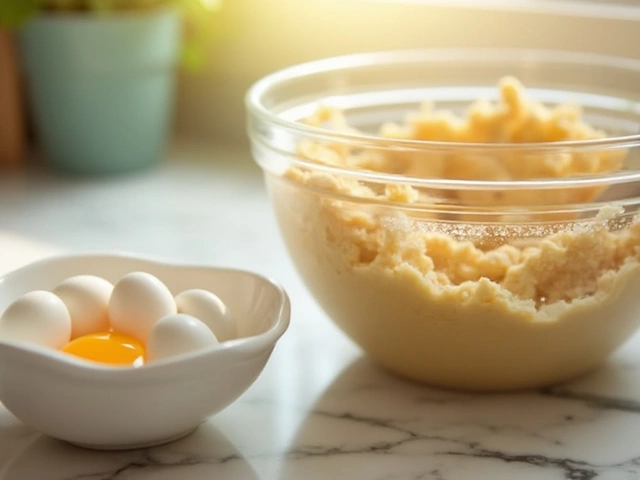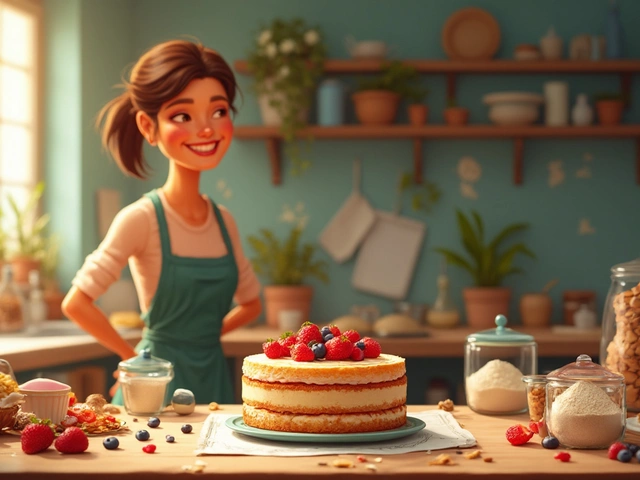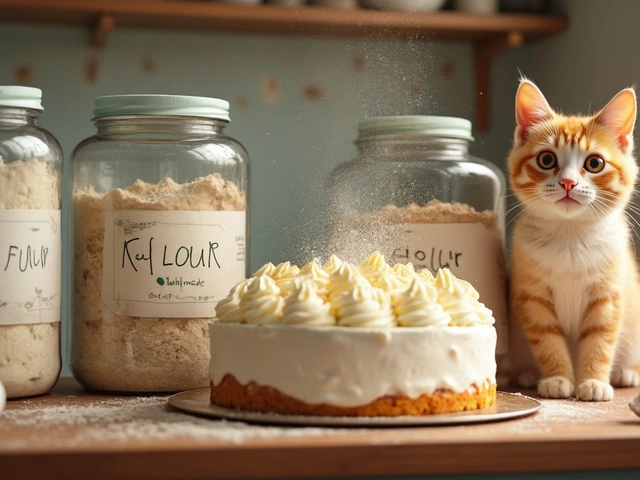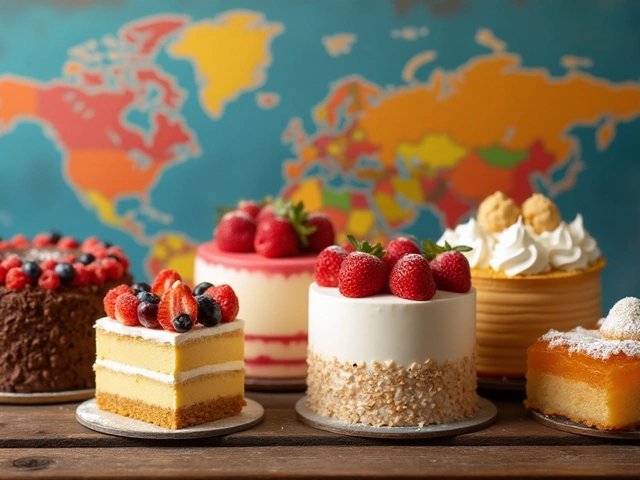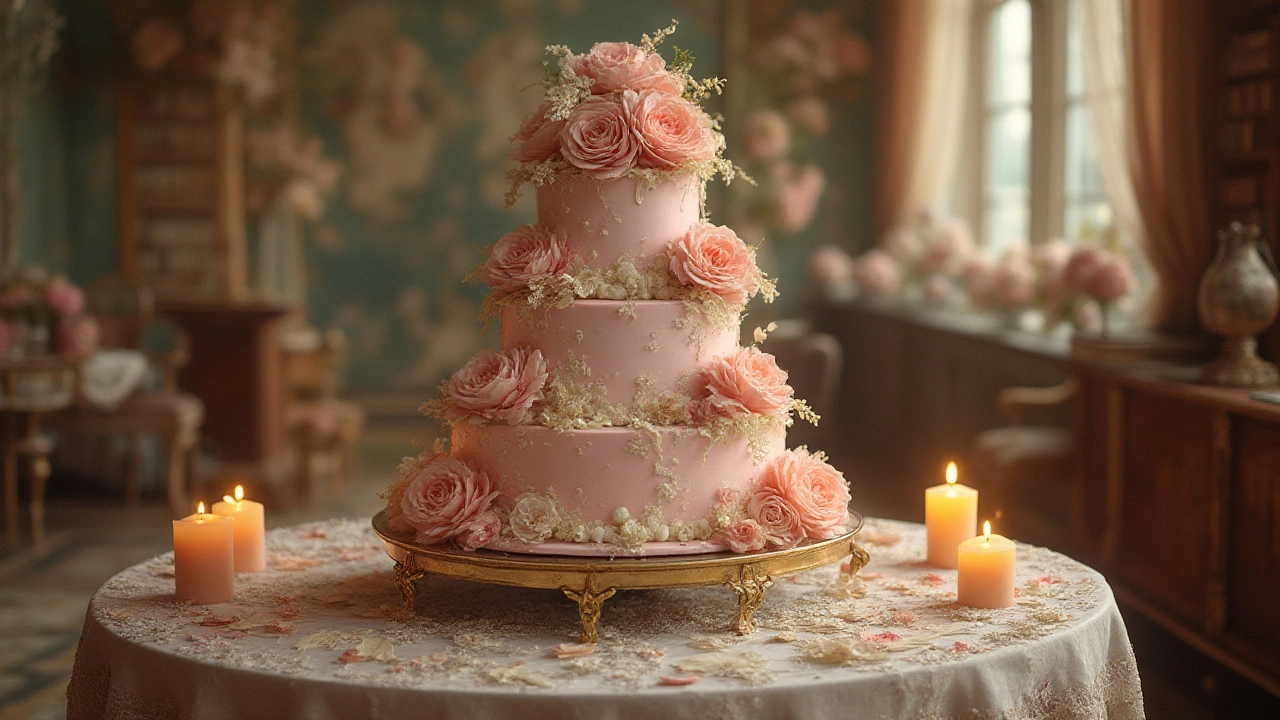
When you picture a wedding, what pops into your mind first? For plenty of folks, it's that towering, frosted beauty at the center of the reception: the wedding cake. But have you ever wondered if "wedding cake" is the only name it goes by? And where did the idea of having this grand cake at weddings even come from? It's wild how something as simple as dessert can pack so much tradition, symbolism, and even superstition into its layers. Wedding cakes have become such showstoppers and symbols, people often forget these confectionery icons had a pretty humble — and sometimes bizarre — start.
The Many Names and Meanings of the Wedding Cake
Alright, let's clear it up straight away: in English-speaking places, the official term is "wedding cake." Pretty obvious, right? Sometimes you'll hear it called the “bridal cake,” especially in old-fashioned circles. But that's not all—throughout history and across the world, they've gone by all sorts of names. In France, they fancy things up by calling it a “gâteau de mariage.” Italians serve a "torta nuziale." Back in Victorian England, the phrase "bride’s cake" was the go-to term and usually referred to a dense fruitcake covered in stiff white icing. That color meant more than just a love for vanilla — it stood for purity and luxury, since refined sugar was a pricey treat reserved for the upper class.
If you want to go deep into tradition, ancient Romans had no clue about buttercream or fondant. Their version of a wedding cake, called “mustaceum,” was actually a barely-sweetened barley loaf. Instead of eating it, the groom would break it over the bride’s head as a weird good luck move. Talk about a different kind of crumbly hair accessory. Skip ahead to medieval England — wedding cakes sometimes meant stacks of sweet rolls or scones instead of the single tall tier we know now. Guests tried to kiss over the pile without knocking it over. Supposedly, if you didn’t topple the stack, your marriage would be a sweet one. Good luck balancing that with a pair of lips smack in the air!
The “wedding cake” name stuck around for a good reason. As weddings became more about spectacle in the Victorian era, the cake morphed into a literal centerpiece. People started using the term “wedding cake” as a symbol for celebration, luxury, and prosperity. Styles evolved, too — but people kept reaching for gravity-defying layers and ornate decorations. One cool linguistic tidbit: in some US newspapers, especially southern ones, you’ll spot requests for the “groom’s cake”—but that’s a separate tradition with its own story (think smaller, usually chocolate, and sometimes shaped like something quirky, like a football or a favorite pet).
Here’s an interesting table of cake names across different cultures—surprisingly, not every culture even uses a traditional cake at all!
| Country | Name for Wedding Cake | Unique Twist |
|---|---|---|
| England (historic) | Bride's Cake | Heavy fruitcake with white icing |
| France | Gâteau de Mariage | Sometimes a croquembouche (pastry tower) |
| Italy | Torta Nuziale | Often includes layers of sponge, ricotta, and chocolate |
| Sweden | Hochzeitstorte | Princess cake with marzipan and whipped cream |
| China | Wedding Pastries | Lotus seed buns or mooncakes |
| Nigeria | Wedding Cake | Fruitcake layered with fondant, sometimes rum-soaked |
No matter where you go or what it’s called, something sweet is almost always at the heart of the party. And today, wedding cakes aren’t just a dessert — they’re edible showpieces, a slice of culture, and a reflection of the couple’s style. Whether you lean classic or crave something wild (bacon maple cake, anyone?), the wedding cake stands as a symbol of love, luck, and togetherness.
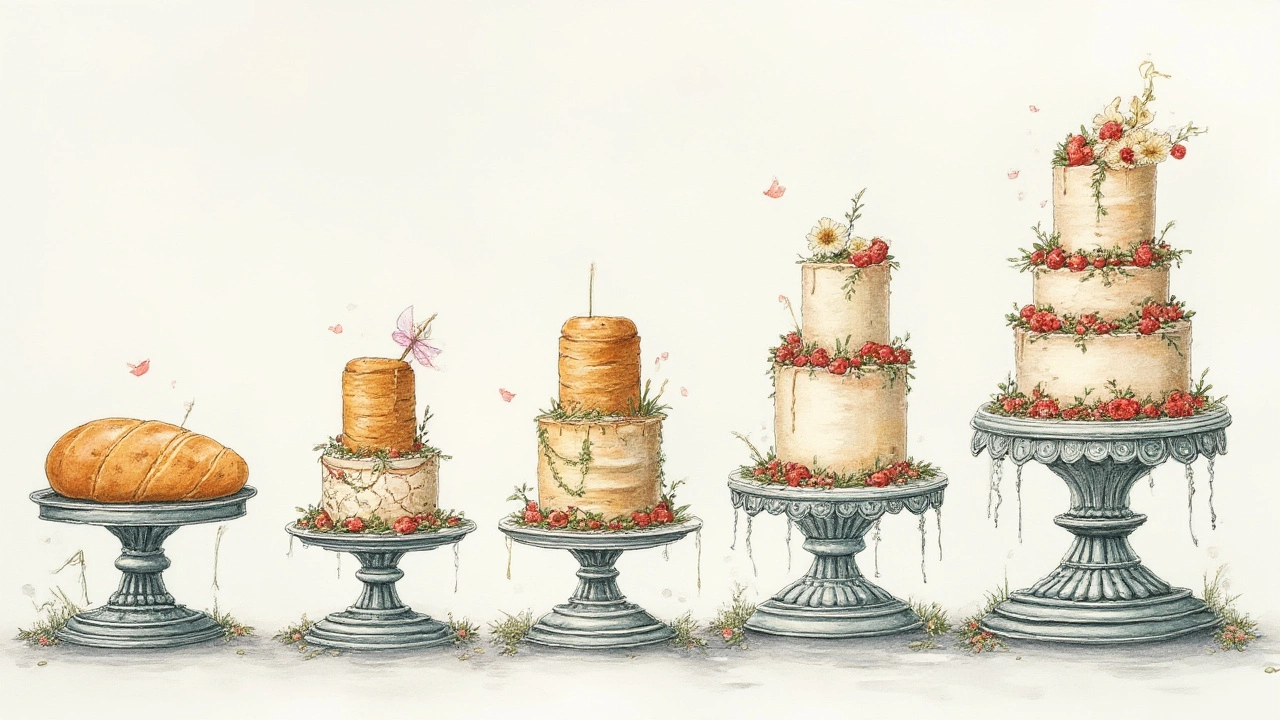
Wedding Cake Traditions, Superstitions, and Hidden Meanings
The wedding cake isn’t just there to satisfy your sweet tooth. Seriously, there’s a mountain of tradition, good luck rituals, and even funky beliefs tied into this sugary marvel. For example, in Victorian England, the top tier of the cake was often saved and stored away to be eaten at the couple’s first child’s christening. Think deep freeze, but before Tupperware was even a thing. Some couples still stick to this tradition — that’s if they can resist the temptation to nibble at midnight after the guests leave.
Cutting the cake is much more than a cute photo-op. This moment goes way back, symbolizing the couple’s very first joint act as a married pair. Back in the day, the bride alone did the cutting to tug at the symbolism of fertility or a long, happy marriage. These days, both partners hold the knife together, showing teamwork right from the start.
Superstitions? There are loads. One says that anyone who sleeps with a slice of the wedding cake under their pillow will dream of their future spouse. (I can’t guarantee sweet dreams if you try this — but watch out for sticky pillowcases.) Some old-school beliefs claim it’s bad luck to bake your own wedding cake. Others insist that if someone else’s tears make it into the batter, you’ll shed happy ones in marriage. People take this stuff seriously!
Let’s not forget about the decorations. Tall cakes once signified greater prosperity — the bigger the cake, the bigger the family's fortunes in theory. White icing? That was the ultimate flex, signaling wealth when only the richest could afford pure white sugar. Today, buttercream and fondant reign, but you’ll spot gold leaf, edible flowers, hand-painted motifs, macarons, meringue drops, and more. It’s not unusual to see cakes inspired by fashion, favorite movies, or hobbies. Some couples even swap cake for towers of donuts, cheese wheels, or literal stacks of pancakes (hello, brunch wedding!).
Check out these fun facts — you can whip these out at your next wedding to sound like a cake expert:
- The Guinness World Record for the tallest wedding cake is a jaw-dropping 17 feet (made by chefs in Connecticut, USA in 2004!).
- Classic fruitcake is so dense with dried fruit and alcohol that it can last for years — Queen Elizabeth and Prince Philip famously ate a preserved tier of their wedding cake at their oldest son’s christening a whole year after tying the knot.
- The average cost of a three-tiered wedding cake in the US is between $300 and $700, but designer cakes can run over $2,000 depending on the decorations and craftsmanship.
- Right before the cake is cut, you might hear a toast to “sweet beginnings” — this phrase goes all the way back to medieval England.
- Modern wedding cakes can be gluten-free, vegan, or any flavor under the sun. Red velvet, carrot, lemon elderflower (hello, Meghan Markle and Prince Harry), or cookies and cream are all fair game.
So, the cake is way more than a dessert or a background prop. It’s the star of the show during the reception, packed with centuries of hopes, stories, and a sprinkle of old-school magic. Whether you’re sticking with multi-tiered marvels or breaking tradition altogether, the wedding cake is there to delight — and maybe, if you believe the legends, bring a bit of luck, too.
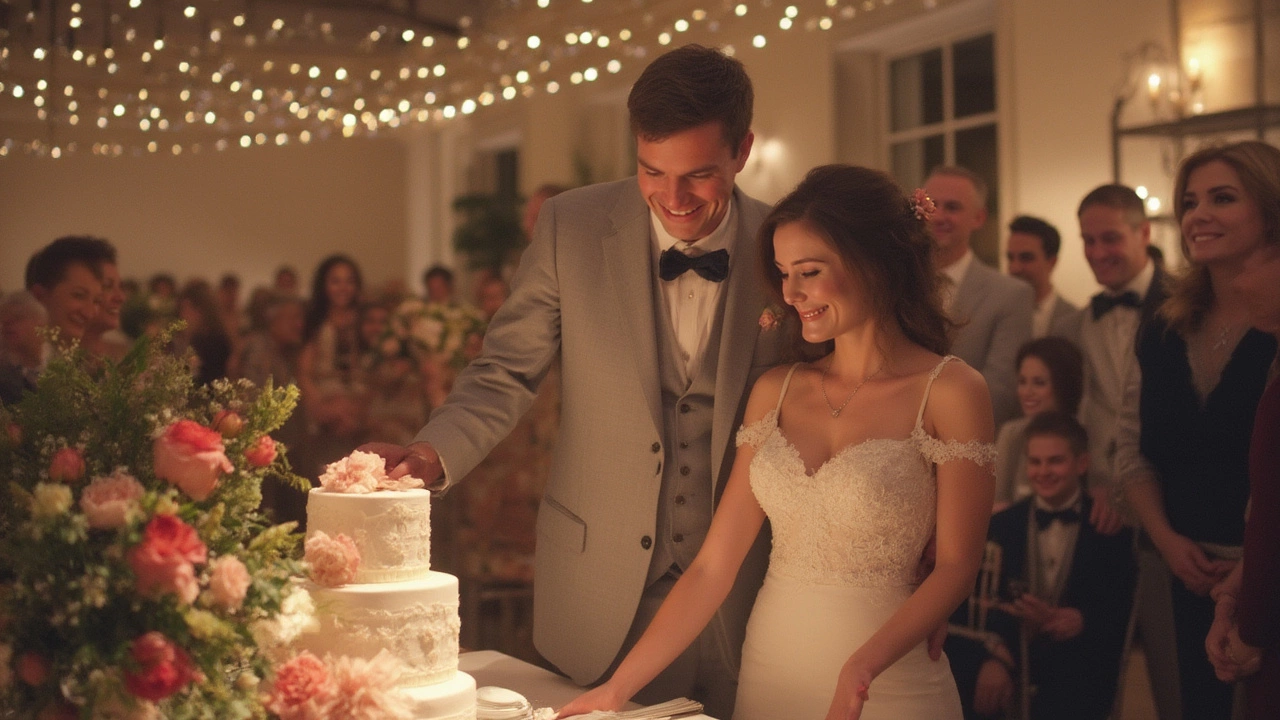
Tips for Choosing, Designing, and Enjoying Your Wedding Cake
Picking out a wedding cake is a seriously fun part of planning the big day, but there’s a lot to think about. First, consider style and theme. Do you want a cake that matches your outfit, flowers, or the vibe of your party? Classic white with sugar flowers is always a hit, but it’s totally okay (and more personal) to pick something colorful, wild, or totally unexpected. Some couples have cakes shaped like castles, favorite animals, or even movie characters. And then there’s flavor — don’t just grab the standard vanilla if you want something exciting. Love lemon and poppy seed? Dreaming of pistachio, mango, or dark chocolate chili? Go for it.
The practical side can’t be ignored either. To serve everyone, use this tip: plan for one slice per guest, but always order a little extra for those who want seconds or late-night snacks. If you’re having a small wedding, tall “dummy” tiers (made from decorated foam) keep the look grand without mountains of leftovers. For huge guest lists, sheet cakes in the kitchen can help keep costs down and slices coming.
Allergy alert! Double-check with your baker about gluten, nuts, or dairy if you or your guests need something special. Modern bakeries whip up delicious gluten-free cakes that taste just as good, and vegan or allergy-friendly cakes are on the rise. Requesting a tasting session is never a bad idea (who can say no to cake samples?), and it’s a perfect time to chat about texture, ingredients, and frosting sweetness. Pro tip: buttercream is creamier and rich, while fondant offers a super-smooth surface for detailed designs but has a firmer bite.
Presentation matters, too. Choose a cake stand that matches your vibe — glass for elegance, wood for rustic, or mirrored for that high-glam look. And placement is key. The cake should be somewhere visible but not in direct sun, especially for outdoor weddings. No one wants melted frosting before the big cut.
If you want to add a meaningful touch, consider custom cake toppers (tiny figurines, favorite quotes, or even pets). Edible flowers, fresh fruit, and hand-painted accents all add wow factor without racking up huge costs. For a bit of fun, serve a "groom’s cake" next to the main cake — it’s a great way to add inside jokes or serve a flavor the bride and groom can’t agree on.
One last tip: assign a friend, family member, or your wedding planner to confirm the cake arrives on time and gets assembled safely. If it’s a hot day, make sure it’s kept cool until it’s showtime. Capture the slicing moment with your photographer — it only happens once, and it’s way more than a photo op. It freezes a moment full of history, hope, and maybe a crumb or two on the dress.
So, what is a wedding cake called? You can call it tradition, centerpiece, or edible art. But really, it's so much more — the sweet heart of the party, tying together history, culture, flavor, and fun. Next time you watch a couple slice into their masterpiece, you’ll know there’s much more beneath the frosting than just sugar and flour.

